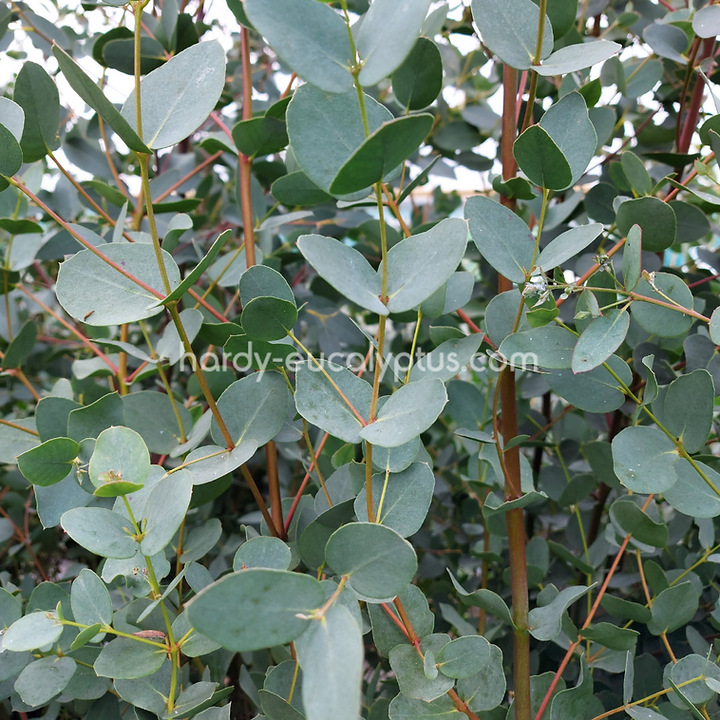
Scourge of the garden centre, bane of the small urban garden, and resilient workhorse of the cut foliage industry; Eucalyptus gunnii is one of the best known, and most reviled eucalyptus species in the UK.
Is this reputation justified?
Well, sort of. But it isn’t the whole story.

Gunnii is easily the most popular eucalyptus species in the UK, if we define popularity as a reflection of abundance and availability. If you see a mature eucalyptus in a garden (or a cheap one in a supermarket) then there is a very good chance that it is a gunnii. It isn’t hard to see why! Gunnii is very hardy, with the classic silvery-blue foliage and fresh fragrance. It is easy to grow as well, which is why you see it so often in garden centres. Lots of eucalyptus species are difficult to grow from seed, and even harder to turn into beautiful young trees for sale. Growing and importing gunnii is the path of least resistance for some, and many an unsuspecting gardener has bought a little gunnii from a garden centre without having any idea what they’ve actually let themselves in for. A bit like the Gremlins, but instead of eating after midnight, the transformation is triggered by being planted in the ground.

It doesn’t help that there is a lot of misinformation about the species to be found online. We won’t name and shame, but some websites claim that gunnii doesn’t get bigger than 15 meters, or even that it is suitable for growing indoors (it really, really isn’t!).
Put simply, E. gunnii is a little bit of a monster. It grows very quickly, at a rate of around 2 meters a year when it is happy. It also reaches a considerable height, anywhere between 20 and 35 meters in maturity. This means that your little gunnii can quickly become a rather big one. In an arboretum or a big garden this isn’t any more of a problem than any large cedar or spruce, but in smaller gardens or near buildings it can become an issue. It doesn’t help that eucalyptus trees grown in round-walled pots tend to have stunted root systems.
What happens if you combine a tall tree, damaged roots, and a windy island?

Above: It is surprisingly hard to find a gif of a tree falling over, but you get the idea.
I know what you’re thinking. “If gunnii is such a bad tree, then why do you grow it?” Well, whilst gunnii has quite a few issues in the wrong context, it can also be a very useful tree. That hardiness and growth rate makes it excellent for screening, provided that it is managed through regular pruning. It will tolerate boggy soil for up to six months of year, making it a rarity amongst evergreen trees. The combination of speed and desirable foliage also makes it an ideal candidate for flower farmers, who aren’t exactly going to let it grow to 30 meters because harvesting foliage from a cherry picker is tedious. We’ve even supplied some gunnii to Kew Gardens, to be kept as pollarded specimens! If you’re fortunate enough to have your own arboretum or even just a large field where eucalyptus trees can frolic freely, then it also makes for a rather impressive specimen tree.

Have you been reading this blog post and growing increasingly aware of the looming gunnii in your garden? If so, you don’t necessarily need to worry. Smooth-walled pots aren’t a guarantee of tree failure, and there are many examples of healthy (and huge) gunnii across the UK. If you had no idea just how big this species can get, then you’ll be happy to know that eucalyptus trees are very responsive to pruning, including more intensive options like pollarding and coppicing. If your tree is still on the small side, then keeping it constrained through regular pruning will be the best way forwards – the taller a tree with damaged roots gets, the greater the force exerted by wind will be.
We agree! And fortunately for you, you can have the aesthetics of gunnii without buying your own polesaw. Eucalyptus archeri reaches 12-15 meters, Azura around 10, and Silverana somewhere between 10 and 12. This makes them small by eucalyptus standards, and not out of place when compared to other common garden trees like birch, lime, or maple. As smaller members and cultivars of the same family, they look very similar to E. gunnii. They also have the same tolerance to pruning as pure gunnii, so you can keep them as small as 2 or 3 meters!
As always, if you have any questions you can just drop us an email or give us a call. We love talking about eucalyptus trees, and doing it at work means that our significant others don’t have to hear about them on the weekends!
Tel: 01905 888 098
Monday-Friday, 9.00am-4.00pm
Grafton Nursery,
Worcestershire
(Visits by appointment)


We’re here to help you choose your Eucalyptus
We’ll also email you with expert seasonal advice for
your Eucalyptus & exclusive offers. No spam – just Eucalyptus.
You can opt out at any time. Click here to see our privacy policy in full.